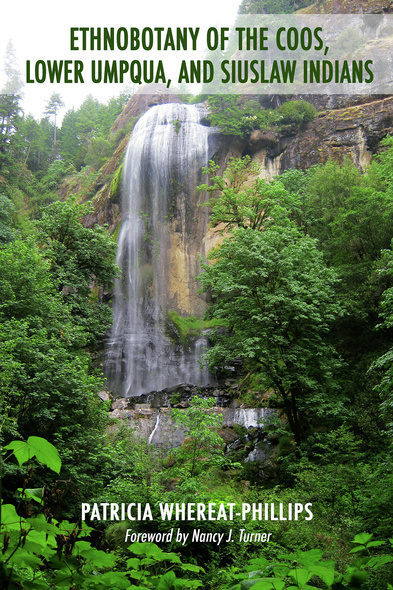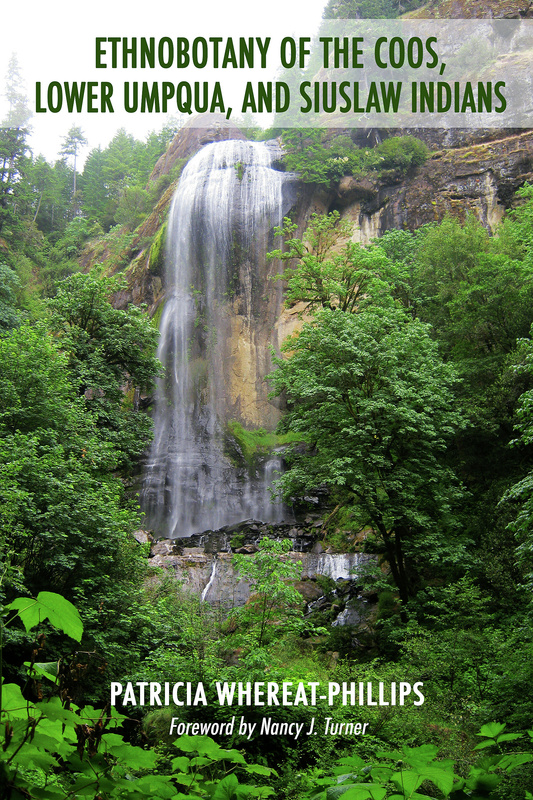
176 pages, 6 x 9
B&W illustrations. Map. Foreword.
Paperback
Release Date:04 May 2016
ISBN:9780870718526
Ethnobotany of the Coos, Lower Umpqua, and Siuslaw Indians
By Patricia Whereat-Phillips; Foreword by Nancy J. Turner
Oregon State University Press
Myrtlewood is most often thought of as beautiful wood for woodworking, but to Native people on the southern Oregon coast it was an important source of food. The roasted nuts taste like bitter chocolate, coffee, and burnt popcorn. The roots of Skunk Cabbage provided another traditional food source, while also serving as a medicine for colds. In tribal mythology, the leaves of Skunk Cabbage were thought to be tents where the Little People sheltered.
Very little has been published until now on the ethnobotany of western Oregon indigenous peoples. Ethnobotany of the Coos, Lower Umpqua, and Siuslaw Indians documents the use of plants by these closely-related coastal tribes, covering a geographical area that extends roughly from Cape Perpetua on the central coast, south to the Coquille River, and from the Coast Range west to the Pacific shore. With a focus on native plants and their traditional uses, it also includes mention of farming crops, as well as the highly invasive Himalayan blackberry, which some Oregon coast Indians called the "white man's berry."
The cultures of the Coos Bay, Lower Umpqua and Siuslaw are distinct from the Athabaskan speaking people to the south, and the Alsea to the north. Today, many tribal members are reviving ancient arts of basket weaving and woodworking, and many now participate in annual intertribal canoe events. Ethnobotany of the Coos, Lower Umpqua, and Siuslaw Indians contributes to this cultural renaissance by filling an important gap in the historical record. It is an invaluable resource for anyone who wishes to learn about the indigenous cultures of the central and southern Oregon coast, as well as those who are interested in Pacific Northwest plants and their cultural uses.
Very little has been published until now on the ethnobotany of western Oregon indigenous peoples. Ethnobotany of the Coos, Lower Umpqua, and Siuslaw Indians documents the use of plants by these closely-related coastal tribes, covering a geographical area that extends roughly from Cape Perpetua on the central coast, south to the Coquille River, and from the Coast Range west to the Pacific shore. With a focus on native plants and their traditional uses, it also includes mention of farming crops, as well as the highly invasive Himalayan blackberry, which some Oregon coast Indians called the "white man's berry."
The cultures of the Coos Bay, Lower Umpqua and Siuslaw are distinct from the Athabaskan speaking people to the south, and the Alsea to the north. Today, many tribal members are reviving ancient arts of basket weaving and woodworking, and many now participate in annual intertribal canoe events. Ethnobotany of the Coos, Lower Umpqua, and Siuslaw Indians contributes to this cultural renaissance by filling an important gap in the historical record. It is an invaluable resource for anyone who wishes to learn about the indigenous cultures of the central and southern Oregon coast, as well as those who are interested in Pacific Northwest plants and their cultural uses.
[Patricia Whereat Phillips] is uncommonly modest, claiming to be neither a botanist nor an anthropologist. Her botanical expertise, however, is impressive as is her ethnographic, ethnohistorical, and ethnolinguistic talents.'
Eugene Hunn, Oregon Historical Quarterly
Steeped in indigenous language and ways of knowing, Patricia Whereat Phillips has written a remarkable ethnobotanical survey of the Coos, Lower Umpqua, and Siuslaw Indians...In a rigorous blending of epistemological approaches, the words of living indigenous people are blended with botanical analysis, archaeology, and ethnohistory to reconstruct a vital plant culture...[A]n admirable example of community-based ethnobotanical research...written not only for an outside audience but also to preserve knowledge for the indigenous communities themselves. This additional and more human imperative is palpable throughout, both in the accessible presentation of information and the opening sections that provide cultural context. Drawing from her Milluk Coos heritage, Phillips shares her 'connection to a place and a family history' with readers, rendering her work valuable far beyond its botanical utility.'
- Grace Ward, Economic Botany
Patricia Whereat-Phillips holds a BS in Biology from Oregon State University and a MA in Linguistics from the University of Oregon, where her studies focused on the Hanis Coos language. She has worked with the US Forest Service in Oregon Dunes National Recreation Area and Mt. Hood National Forest, and served as the Cultural Resources Director for the Confederated Tribes of Coos, Lower Umpqua, and Siuslaw Indians from 1997 to 2001. Subsequently she has worked as a consultant to the Tribes' on traditional language, storytelling, and ethnobotany. She lives in Sonoma, California.




